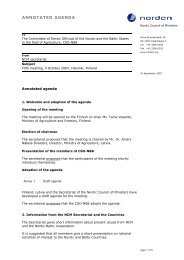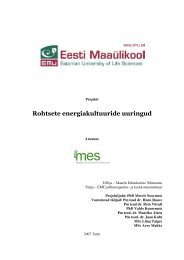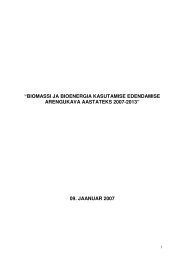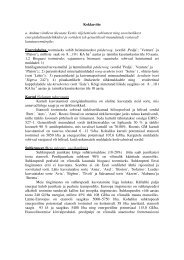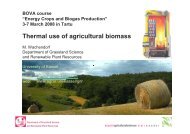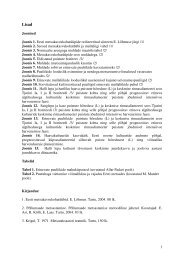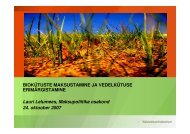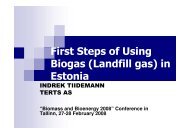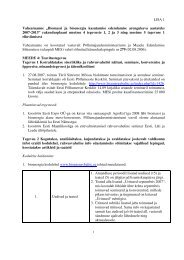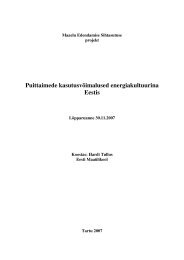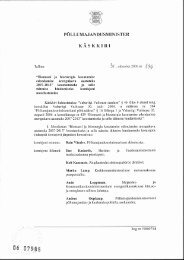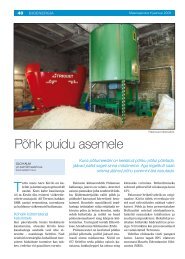Energy hay and straw (PDF) - bioenergybaltic
Energy hay and straw (PDF) - bioenergybaltic
Energy hay and straw (PDF) - bioenergybaltic
You also want an ePaper? Increase the reach of your titles
YUMPU automatically turns print PDFs into web optimized ePapers that Google loves.
The production <strong>and</strong> use<br />
of energy <strong>hay</strong> <strong>and</strong> <strong>straw</strong><br />
MSc Elina Virkkunen<br />
MTT Agrifood Research<br />
Finl<strong>and</strong><br />
MTT Sotkamo<br />
Tarto 4.3.2008
MTT is the leading<br />
research institute in<br />
its field<br />
-operating under the Ministry<br />
of Agriculture <strong>and</strong> Forestry<br />
-employs approximately 850<br />
people, including more than<br />
300 researchers <strong>and</strong> other<br />
experts<br />
-14 locations across Finl<strong>and</strong><br />
-the budget for 2006 was EUR<br />
46 million, one third of which<br />
comes from outside<br />
-www.mtt.fi/english
MTT Sotkamo, Kainuu region<br />
• Northern lake area<br />
– Snow cover 4 to 6 months<br />
– Thermal growing period 3,5 months<br />
• Research subjects<br />
– Bioenergy<br />
• Field energy in Kainuu (developing project)<br />
• Fertilization of reed canary grass<br />
• Observational research in energy willow etc.<br />
• Pilot biogas reactor (spring/summer 2008)<br />
– Berry research<br />
– Grassl<strong>and</strong> farming<br />
• 40 ha field, 7 workers + summer workers
<strong>Energy</strong> consumption <strong>and</strong> sources in Finl<strong>and</strong> 2005<br />
Wood industry<br />
17%<br />
Wood home<br />
4%<br />
Other<br />
2%<br />
Oil<br />
26%<br />
Peat<br />
5%<br />
Wind <strong>and</strong> water<br />
4 %<br />
Import electr.<br />
4%<br />
Nuclear<br />
energy<br />
18%<br />
Source: Finl<strong>and</strong>'s annual inventory report on greenhouse gases<br />
http://www.stat.fi/til/ehkh/2006/03/ehkh_2006_03_2006-12-20_tau_001.xls<br />
Coal<br />
9%<br />
Natural gas<br />
11%<br />
Total energy<br />
consumption in Finl<strong>and</strong><br />
in 2005: 1 366 295 TJ<br />
(380 TWh)
Field use in Finl<strong>and</strong> in 2006<br />
1 %<br />
1 %<br />
1 %<br />
1 %<br />
1 %<br />
1 %<br />
Cereals<br />
Forages<br />
Fallow<br />
5 %<br />
Oilseeds<br />
Pastures 5 years<br />
11 %<br />
27 %<br />
51 %<br />
Reed canary grass<br />
Potato<br />
Sugar beet<br />
Caraway<br />
Other crops<br />
Field area 2.3 mill. ha<br />
Source: MMM/Matilda 2006
Scenario for field use in 2012<br />
(Ministry of Agriculture <strong>and</strong> Forestry)<br />
4 % 4 % 43 %<br />
11 %<br />
4 %<br />
4 %<br />
23 %<br />
7 %<br />
Cereals<br />
Cereals for ethanol<br />
Forage<br />
Fallow<br />
Oilseeds for food<br />
Oilseeds for energy<br />
Reed canary grass<br />
Other crops<br />
• Field area 2,3 Mha<br />
• For food <strong>and</strong> feed<br />
production 1,8 Mha<br />
• For energy<br />
production max 0,5<br />
Mha
Reed canary grass<br />
Phalaris arundinacea L.<br />
(RCG) in Finl<strong>and</strong><br />
• In 2007 there was 20 000 ha RCG in Finl<strong>and</strong><br />
• The target at the year 2015 is 100 000 ha RCG<br />
• The total area of agricultural l<strong>and</strong> in Finl<strong>and</strong> is 2,3<br />
million hectares. 0,5 million ha of it could be set<br />
aside or used for non-food production.<br />
• Used varieties (Chiefton, Palaton, Lara, Venture)<br />
are all developed for fodder production<br />
– They are not perfect for the energy purpose because of<br />
the high leaf content<br />
– Breeding for energy purpose is going on
RCG uses nutrients effectively<br />
• A native, perennial grass, grows also in Lapl<strong>and</strong><br />
• In the shores of lakes <strong>and</strong> rivers, in ditches, at the verge of the roads<br />
• 80─200 cm high<br />
• Strong rootstock<br />
(mostly 2─8 cm deep)<br />
-> st<strong>and</strong>s well wetness <strong>and</strong> draught<br />
• Sprouts continue growing<br />
late in the autumn<br />
• Utilizes well ash, slurry <strong>and</strong> compost<br />
• Before winter the nutrients transfer to<br />
the roots ─> does not need much<br />
fertilizers
RCG is good for soil<br />
• Prevents erosion<br />
• Reduces N <strong>and</strong> P leaching 40 %<br />
compared to cereals<br />
• Improves the texture of the soil<br />
• Adds the humus <strong>and</strong> coal content of<br />
the soil because of the rootstock<br />
• If needed, the field area can<br />
be taken to food or fodder<br />
production<br />
• The l<strong>and</strong>scape stays open<br />
• Offers shelter for wild <strong>and</strong> game<br />
animals
RCG grows at least 10 years<br />
• RCG grows best in organic soil<br />
• Biological yield 5─8 tons dry matter/ha<br />
(1 tn DM = 4,5 - 4,9 MWh)<br />
• Produces crop at least 10 years<br />
• First harvesting two years after seeding<br />
• Harvesting in April or May<br />
– Low moisture content in spring (10-15%)<br />
– Low alkali <strong>and</strong> chloride content in spring<br />
– More cellulose (<strong>straw</strong>) in spring than in autumn<br />
• After sowing year doesn’t need much work<br />
– good for part-time or retiring farmers
Ruokohelven kasvu edellisenä vuonna<br />
Growth habbit of reed canary grass<br />
*<br />
* * *<br />
* * * *<br />
*<br />
* *<br />
*<br />
Toukokuu<br />
May<br />
Heinäkuu<br />
July<br />
Elokuu<br />
August<br />
Syksy – talvi<br />
Sept-April<br />
Toukokuu<br />
May<br />
Kasvu edellisenä kesänä<br />
Talven lumiolot Korjuu<br />
Growth in the previous year Snow cover Harvesting<br />
K. Pahkala 05
November<br />
K.Pahkala<br />
September<br />
K.Pahkala<br />
April<br />
E.Virkkunen
Sowing of the RCG<br />
• control of the quick grass in the previous autumn<br />
• good water ditches<br />
• collecting stones<br />
• good cultivation -><br />
flat field surface<br />
• sowing shallow<br />
enough (1-2 cm)<br />
• rolling after sowing<br />
• weed control<br />
Photos: E.Virkkunen
RCG farming (Katri Pahkala)<br />
• -----------------------------------------------------------------------------<br />
-----1st year May Sowing, seed 11 kg/ha<br />
Fertilization N 40-60 kg/ha<br />
June Weed control<br />
• Plants 0.8 - 0.9 m in November<br />
• -----------------------------------------------------------------------------<br />
-----<br />
• 2nd year May Fertilization N 60-90 kg/ha<br />
• Plants 1.5 - 2 m in November<br />
• -----------------------------------------------------------------------------<br />
-----3rd - 16th year<br />
• May 1st - 15th harvest 7-8 t/ha DM<br />
• May Fertilization N 60-90 kg/ha<br />
• Plants 1.5 - 2 m in November
Fertilization <strong>and</strong> soil type<br />
Katri Pahkala<br />
Sato DM yield kg/ha<br />
9000<br />
8000<br />
7000<br />
6000<br />
5000<br />
4000<br />
3000<br />
2000<br />
1000<br />
0<br />
Jokioinen Ruukki Vihti<br />
Savimaa Clay Hietamaa Loamy s<strong>and</strong> Multamaa Humus<br />
0 N<br />
50 N<br />
100 N<br />
150 N
RCG harvest: mowing<br />
• mowing is the critical part of harvest<br />
– the snow lodges the crop very badly<br />
– the crop is fragile<br />
– when the grass was harvested at 5 cm<br />
instead of 10 cm, the yield losses increases<br />
25 % (Lötjönen 2006)<br />
– use special cutting blades for lodged plants<br />
– when using conditioner, decrease rotation<br />
speed
Effect of stubble height<br />
Sato kg/ha<br />
Dm yield<br />
Niittokorkeuden vaikutus<br />
7000<br />
6000<br />
5000<br />
4000<br />
3000<br />
2000<br />
1000<br />
0<br />
Stubbble height<br />
0 1 2 3<br />
Korjuuaika Harvesting date<br />
5 cm 10 cm<br />
5 cm 10 cm<br />
100<br />
90<br />
80<br />
70<br />
60<br />
50<br />
40<br />
30<br />
20<br />
10<br />
0<br />
Kuiva-aine %<br />
Dm%<br />
• Stubble height markedly<br />
affected the harvested DM<br />
yield <strong>and</strong> DM content of reed<br />
canary grass.<br />
• When grass was harvested at<br />
5 cm instead of 10 cm, the<br />
DM yield was more than 30%<br />
higher<br />
• The harvest period allowed<br />
by weather conditions<br />
ranged from 10 to 15 days in<br />
Finl<strong>and</strong>.<br />
Korjuuaika: viikkoja ensimmäisestä mahdollisesta korjuupäivästä (=0)<br />
Harvesting date: weeks from the first possible harvesting date (=0)<br />
K.Pahkala et al. 05
Yield <strong>and</strong> purity of reed canary grass (RCG)<br />
harvested in August <strong>and</strong> May<br />
• Dry matter (DM)<br />
yield of RCG<br />
harvested in spring<br />
improves after the<br />
first harvesting<br />
• Yield of RCG was<br />
higher if harvested in<br />
spring instead of<br />
August<br />
• RCG trial sown in<br />
1990 stayed<br />
productive 16 years<br />
if harvested in spring<br />
K. Pahkala 2007<br />
kg/ha<br />
DM yield kg/ha<br />
9000<br />
8000<br />
7000<br />
6000<br />
5000<br />
4000<br />
3000<br />
2000<br />
1000<br />
0<br />
August<br />
May<br />
1991<br />
1992<br />
1993<br />
1994<br />
1995<br />
1996<br />
1997<br />
1998<br />
1999<br />
2000<br />
2001<br />
2002<br />
2003<br />
2004<br />
2005<br />
2006<br />
2007<br />
Reed canary grass % of dry matter (DM)<br />
% of DM<br />
100<br />
80<br />
60<br />
40<br />
20<br />
0<br />
1991<br />
1992<br />
1993<br />
1994<br />
1995<br />
1996<br />
1997<br />
1998<br />
Trial was sown in 1990/MTT<br />
1999<br />
2000<br />
2001<br />
2002<br />
2003<br />
2004<br />
2005<br />
2006<br />
2007
Two experiments were set up in 2006 – 2007:<br />
(Timo Lötjönen, Mika Isolahti))<br />
1) Autumn / spring mowing experiment<br />
2) Spring mowing experiment<br />
Biological yield was measured by Haldrup.
Autumn<br />
Experiment 1: Autumn / spring mowing<br />
Photo: Timo Lötjönen,<br />
Mika Isolahti<br />
Autumn<br />
Spring<br />
Spring<br />
Spring
Results:<br />
- the winter caused 15 – 28 % yield losses<br />
100.0<br />
90.0<br />
80.0<br />
Gained RCG yield, %<br />
70.0<br />
60.0<br />
50.0<br />
40.0<br />
30.0<br />
20.0<br />
10.0<br />
0.0<br />
Treatment A<br />
Conditioner in autumn<br />
Treatment B<br />
Disc mower in autumn<br />
Treatment C<br />
Conditioner in spring<br />
Figure 1. Gained RCG yield in Autumn mowing experiment. (= Dry matter of<br />
harvested yield / Dry matter of biological yield in the spring x 100 %)<br />
The bars indicate min. <strong>and</strong> max. values. (Lötjönen, Isolahti)
Table 1. Quality of RCG in Autumn mowing experiment. (Lötjönen, Isolahti)<br />
Sampling date 4.10.06 13.10.06 28.5.07<br />
Treatment A<br />
Conditioner<br />
in autumn<br />
Treatment B<br />
Disc mower<br />
in autumn<br />
Treatment C<br />
Conditioner<br />
in spring<br />
Cl g/kg dm. 3.4 3.6 1450
Experiment 2: Spring mowing<br />
Photo: Lötjönen, Isolahti
100<br />
90<br />
80<br />
70<br />
Gained yield (%)<br />
60<br />
50<br />
40<br />
30<br />
20<br />
10<br />
0<br />
Disc mower +<br />
rake 1.<br />
Disc mower +<br />
rake 2.<br />
Conditioner mower<br />
+ rake 1.<br />
Swather + rake 1. *) Misadjusted disc<br />
mower + rake 1.<br />
Figure 2. Gained RCG yield in Spring mowing experiment. *) The green bar<br />
was measured in Baling experiment, which located in the next field.
Baling experiment in 2007, Photos: Lötjönen, Isolahti)<br />
Fixed chamber Welger-round baler<br />
New Holl<strong>and</strong>-square baler<br />
Variable chamber Vicon-round baler<br />
Claas-square baler (vm. 1997)
Conclusions:<br />
-the late autumn mowing of RCG can be done,<br />
but here it was not very effective<br />
-in the spring harvest the most important things are<br />
to avoid too long stubble <strong>and</strong> fall of losses<br />
-also disc mower with conditioner can achieve low harvest<br />
losses with correct adjustments<br />
-swather mower has low losses, but it is slow<br />
-level 80 % as gained yield is a good result in RCG harvest
Timo Lötjönen<br />
RCG harvest (Timo Lötjönen)<br />
Round baler<br />
• it is important to try to make<br />
so tight bales as possible<br />
• fixed chamber 120 kg/m3<br />
• variable chamber 160 kg/m3
Baling: Square baler<br />
•195 kg/m3, shape is better for transport<br />
•very heavy <strong>and</strong> expensive machines<br />
Photo: NewHoll<strong>and</strong>
Loose harvest:<br />
•density of the chaff<br />
can be only 70-100 kg/m3<br />
•chaff is transported to peat bog,<br />
where it is mixed to peat<br />
•distance to peat bog<br />
should be < 10 km<br />
Timo Lötjönen
Avoid this !!!<br />
Mika Isolahti<br />
Mika Isolahti
EFFICIENCY OF THE<br />
BALE TRANSPORTATION<br />
A) Round baler, fixed chamber (d=1,3 m) 15,4 tn<br />
B) Round baler, variable chamber<br />
(d=1,6 m) 16,6 tn => + 8 %<br />
C) Square baler (1,2 x 0,7 x 2,4 m)<br />
23,4 tn => + 52 %<br />
Timo Lötjönen 2008
Harvest chains <strong>and</strong> transport<br />
1) Mowing 2) Collecting 3) Field<br />
transport<br />
Disc<br />
mower<br />
Swather<br />
Round baler<br />
Square baler<br />
Forage<br />
harvester<br />
Pick-up<br />
wagon<br />
Bale<br />
spikes<br />
Forest<br />
trailer<br />
Bale<br />
trailer<br />
Silage<br />
trailer<br />
4) Field<br />
storage<br />
Plastic<br />
cover<br />
Plastic<br />
cover<br />
<strong>and</strong><br />
Mixing<br />
to peat<br />
5) Road<br />
transport<br />
Log<br />
truck<br />
Brushwood<br />
truck<br />
Peat<br />
truck<br />
6) Heat <strong>and</strong><br />
electricity<br />
production<br />
Bale<br />
crushing<br />
Combustion<br />
The most commonly used<br />
The second commonly used<br />
Timo Lötjönen 2006
Challenges of RCG<br />
harvesting<br />
<strong>and</strong> transportation (Lötjönen)<br />
• the harvest losses 40 – 60 %<br />
• too heavy machines -> problems in<br />
bearing capacity of the fields<br />
• low density in transportaton -> high costs<br />
• suitable for bricketing, but increases costs<br />
• also problems in combustion
For instance timber should<br />
be placed under the bales.<br />
The bales are<br />
stored in the<br />
farmers field next to<br />
the road.
Crushing RCG<br />
(Vapo Oy Olli Reinikainen)
Straw as a biofuel<br />
• The share of <strong>straw</strong> is about 30-50% of the total<br />
cereal biomass<br />
• By-product – low production costs<br />
• Rye <strong>and</strong> wheat <strong>straw</strong> are best fuels<br />
• The energy value 4,8 MWh/tn dry matter<br />
• Widely used as a fuel in Denmark, not in Finl<strong>and</strong><br />
• Problems:<br />
– High ash content (4-9%) <strong>and</strong> composition of silica <strong>and</strong><br />
alkali metals.<br />
– High moisture content at harvesting. Harvesting time<br />
in average is only 10-12 days in Finl<strong>and</strong>.
Straw as a biofuel<br />
• The quality of the grey <strong>straw</strong> is better than the yellow <strong>straw</strong><br />
– the rain rinses chlorine <strong>and</strong> alkali metals<br />
• Straw is also a possible raw material for bio ethanol<br />
Oil plant stem<br />
– energy value is ~ cereal <strong>straw</strong><br />
– contain less chlorine, but more sulphur than cereal <strong>straw</strong><br />
Fibre hemp<br />
- possible raw material when harvested in spring<br />
- yield 5-10 ton dry matter/ha<br />
- has to be seeded every year<br />
- needs a lot of water <strong>and</strong> nutrients<br />
Centaurea jacea
Grains<br />
Jyvät<br />
Cereals in industry use<br />
Starch industry<br />
Tärkkelysteollisuus<br />
Feeds (farms) Rehut<br />
Feed industry<br />
Rehuteollisuus<br />
Food stuffs Elintarvikkeet<br />
Textile Tekstiili<br />
Paper Paperi<br />
Degradable plastics<br />
Hajoavat muovit<br />
Alcohol Alkoholi<br />
Processed feeds<br />
Rehusekoitukset<br />
Straw chips<br />
Olkisilppu, olkijauho<br />
Power plants<br />
Energialaitokset<br />
Pulping industry<br />
Selluteollisuus<br />
Building industry<br />
Levyteollisuus<br />
Alcohol<br />
Alkoholi<br />
Heat <strong>and</strong> power<br />
Lämpö ja sähköenergia<br />
Paper <strong>and</strong> board<br />
Paperi ja pahvi<br />
Biocomposites<br />
Rakennuslevyt<br />
2nd generation biofuels<br />
2. sukupolven polttonesteet<br />
K. Pahkala 07
<strong>Energy</strong> Potential <strong>and</strong> Efficency of Agro<br />
Biomass in Direct Combustion K.Pahkala<br />
<strong>Energy</strong> in<br />
<strong>Energy</strong> out<br />
Reed CG Straw<br />
Whole Grain
Properties of different<br />
materials in combustion Alakangas, E. 2000<br />
Combustion property RCG<br />
<strong>Energy</strong> value in dry<br />
mater MWh/tn<br />
Wheat <strong>straw</strong><br />
wood<br />
4,9 4,8 5,3 6<br />
peat<br />
Moisture, % 14 15 50 40<br />
Ash content, %<br />
Ash melting point, o C<br />
5,5<br />
1404<br />
7<br />
930<br />
1,5<br />
1150<br />
4<br />
1100<br />
Sulphur, S % 0,1 0,15 0,05 0,25<br />
Chlorine, Cl % 0,09 0,5 0,02 0,05<br />
Potassium, K % 0,2 0,8 0,2 0,05<br />
Calcium, Ca % 0,2 0,4 0,3 0,5<br />
Magnesium, Mg % 0,05 0,1 0,05 0,05<br />
Natrium, Na % 0,01 0,1 0,01 0,01<br />
Silica, Si % 1,8 1,8 0,4 0,8
The influence of the moisture to<br />
the heat value of the RCG (Vapo Oy,<br />
Olli Reinikainen)<br />
Ruokohelpin saapumistilan tehollisen lämpöarvon MWh/t<br />
riippuvuus kosteudesta<br />
5,500<br />
5,250<br />
5,000<br />
Teholl. lämpöarvo, MWh/t<br />
4,750<br />
4,500<br />
4,250<br />
4,000<br />
3,750<br />
3,500<br />
3,250<br />
3,000<br />
0 5 10 15 20 25 30 35<br />
Kosteus, m-%<br />
18,00 M J/kg = 5,000 M Wh/t
Farming of reed canary grass RCG<br />
RCG is grown for energy production<br />
on bogs after peat production<br />
<strong>and</strong> on farms as contract cultivation<br />
Reed canary grass area (hectares)<br />
High expectations in production<br />
increase. Vapo <strong>and</strong> Pohjolan Voima<br />
biggest producers.<br />
Area ha<br />
100000<br />
90000<br />
80000<br />
70000<br />
60000<br />
50000<br />
40000<br />
30000<br />
20000<br />
10000<br />
0<br />
Growing of reed canary grass<br />
1600<br />
4500<br />
300 500 900<br />
100 000?<br />
20400<br />
17200<br />
10500<br />
2000 2001 2002 2003 2004 2005 2006 2007 2015<br />
MMM/Tike 2006<br />
Source: Tike/Matilda 2000-2007, 2015 Scenario of Ministry<br />
of Agr&For
Foto: Pohjolan Voima Oy<br />
Use of reed canary grass (RCG) for<br />
energy in Finl<strong>and</strong> (Katri Pahkala)<br />
Oy Alholmens Kraft Ab, Pietarsaari<br />
Foto: K. Pahkala<br />
www.alholmenskraft.com<br />
• 590 MWth biofuel fired CFB<br />
• started production year 2001<br />
• In Finl<strong>and</strong>, more than 20 plants<br />
have experience of RCG use in<br />
combustion. Use in 2006: 21 GWh<br />
(Vapo Oy)<br />
• More than 100 power plants with a<br />
rated thermal input of more than 20<br />
MW are able to use grass <strong>and</strong> <strong>straw</strong><br />
biomass in fluidized bed<br />
combustion<br />
• The highest share of RCG used is<br />
15% of the total energy value of the<br />
fuel<br />
• RCG differs from other bio fuels: it<br />
is dry (moisture 10 – 20 %) <strong>and</strong> very<br />
light.<br />
• The energy value for RCG is 5<br />
MWh/tn dm <strong>and</strong> 4.2 MWh/tn at 14%<br />
moisture content (Vapo).<br />
• Enterprises are interested in<br />
increasing activities in using RCG:<br />
the use will be 1.5 TWh in 2016<br />
(source Vapo Oy)
Delivery <strong>and</strong> the price of RCG<br />
(Katri Pahkala)<br />
• Vapo Oy <strong>and</strong> Pohjolan Voima Oy are the largest<br />
concerns that buy RCG.<br />
• Delivery of RCG is based on contracts between farmers<br />
<strong>and</strong> the power plant<br />
• The price for the RCG biomass energy value is<br />
calculated on the dry matter yield, moisture content <strong>and</strong><br />
the distance to the power plant. Highest when moisture<br />
content is less than 14%, DM yield more than 6 t/ha <strong>and</strong><br />
the field situated close to the plant.<br />
• Optimum distance less than 60 km to the power plant<br />
• Subsidies for RCG growing as an energy crop are 530 –<br />
600 euros per hectare.<br />
– Whereof 45 eur/ha specific energy subsidy, the rest same<br />
subsidy as for food production
The Danish technology of <strong>straw</strong><br />
combustion suits also for RCG<br />
combustion in smaller plants.<br />
Figure: Reka AS
Future challenges for RCG production<br />
(Katri Pahkala)<br />
• Contract growing <strong>and</strong> use of RCG as solid fuel is increasing<br />
(higher oil price, emission trade) especially in regions with more<br />
fields than forest:<br />
– if the price of the product is reasonable, or subsidies stay high<br />
– if the logistic chains will be improved, <strong>and</strong> problems at power plants are<br />
solved (light, dry fuel, crushing of bales, attitudes against a ”new” fuel)<br />
• Owners of one-family houses are interested to exchange their<br />
heating systems from oil or electricity to bio fuel:<br />
– logistic chains should be improved also for private users<br />
• Use of RCG as biogas raw material is possible at green stage<br />
– If the biogas plants become common<br />
• Use as ethanol raw material possible<br />
– materials can be easily hydrolysed to monosaccharides <strong>and</strong> fermented to<br />
ethanol<br />
– energy intensive processing system should be improved<br />
• Environmental impacts:<br />
– results promising, positive impacts to the climate change
Fibre <strong>and</strong> energy<br />
projects in MTT (K.Pahkala)<br />
• Agrofibre production <strong>and</strong> utilization for pulp <strong>and</strong> papermaking in Finl<strong>and</strong> 1990<br />
– 1997<br />
• Methods developed in the project were applied in September 1995, when bleached<br />
reed canary grass pulp was produced on a pilot scale <strong>and</strong> made into paper on pilot<br />
paper machine of KCL. Offset printing.<br />
• Design, development <strong>and</strong> up-scaling of a sustainable production system for hemp<br />
textiles: an integrated quality systems approach 2003 – 2005 (EU project)<br />
• Biomass production for energy 1994 – 2002<br />
• Options for Achieving the target of 45 MTOE from energy cropping in the EU<br />
in 2010 (Altener II) 2001-2003 (EU project)<br />
• Greenhouse gas emissions <strong>and</strong> new business concepts for liquid biofuels<br />
2005 - 2006.<br />
• Fuel ethanol production from agricultural wastes <strong>and</strong> reed canary grass 2005<br />
– 2007
Some results<br />
of the projects<br />
• The concept of large-scale cultivation of reed canary grass, was<br />
described as a result of crop management research (Saijonkari-<br />
Pahkala 2001)<br />
• Breeding reed canary grass for non-food purposes started in Finl<strong>and</strong><br />
(Sahramaa 2003)<br />
• Methods developed in the project were applied in September 1995,<br />
when bleached reed canary grass pulp was produced on a pilot<br />
scale <strong>and</strong> made into paper on pilot paper machine of KCL. Offset<br />
printing.<br />
• Calculations <strong>and</strong> economical analysis for the pulp <strong>and</strong> paper mill<br />
using reed canary grass were made by Jaakko Pöyry Oy<br />
• Tests in full scale paper mill (EU project)<br />
(Paavilainen et al. 1999)
<strong>Energy</strong> grass farming for<br />
power plants in<br />
Ostrobothnia 2002 – 2005<br />
• Reed canary grass area is 1800 ha (170 farms<br />
in 2005) <strong>and</strong> will be increased to 4000 ha<br />
• 1500 farmers have been trained by MTT to grow<br />
RCG<br />
• The area has served as “full scale pilot” for the<br />
Governement<br />
• Example of good co-operation between farmers,<br />
research <strong>and</strong> power plants<br />
• Problems in the full scale production have been<br />
stated<br />
• ”Profile” of reed canary grass grower
Field energy in Kainuu –project<br />
2004-2007<br />
• The aims:<br />
– To activate the field energy production in Kainuu<br />
– To transfer neutral research knowledge to farmers (education, field<br />
trips, farm advising, journal articles)<br />
– To find new production alternatives to farmers, local harvesting<br />
contractors <strong>and</strong> engineering works.<br />
• The achievements:<br />
– The farmers were very interested in this new crop. 10 % of the<br />
farmers in the region took part in the events. (118 farmers)<br />
– First farmers sowed RCG in spring 2005. The current cultivation area<br />
is 268 ha (25 farmers) + 300 ha ab<strong>and</strong>oned peat production areas by<br />
Vapo Oy<br />
– The advancement work of a bale shredder.<br />
– According to the research “Agroenergy Programme for Eastern<br />
Finl<strong>and</strong> until 2020”, the potential energy plant cultivation in Kainuu is<br />
26 600 ha. Most of it are peat fields, that are not used for farming now
Elina Virkkunen<br />
Learning in the field..<br />
Elina Virkkunen<br />
…<strong>and</strong> in the class room
Field energy is good material in<br />
biogas production<br />
Methane yields of fresh matter (Lehtomäki 2006)<br />
Material<br />
Methane yield m 3 /tFM<br />
Animal manure 7-20<br />
Biowaste 100-150<br />
Timothy-clover grass 72-85<br />
RCG 97-167<br />
Red clover 41-68<br />
Jerusalem artichoke 110<br />
Nettle 25-60<br />
Oats <strong>straw</strong> 260
Dry matter, methane <strong>and</strong> energy<br />
yields of crops (A. Lehtomäki 2006)<br />
substrate<br />
Yield<br />
t TS<br />
/ha<br />
Methane yield<br />
m 3 CH4/ha<br />
Gross energy<br />
yield<br />
MWh/ha<br />
RCG 9-10 3800-4200 28-50<br />
Red clover 5-7 1400-1900 13-18<br />
Jerusalem<br />
artichoke<br />
Straw of<br />
oats<br />
9-16 3100-5400 30-53<br />
2 600 6
References<br />
- ALAKANGAS, E.2000. Properties of fuels used in Finl<strong>and</strong> VTT Tiedotteita 2045.<br />
http://www.vtt.fi/inf/pdf/tiedotteet/2000/T2045.pdf<br />
- ISOLAHTI, M. Ruokohelven korjuu vaatii taitoa. Koetoiminta ja käytäntö 62 (2005):3(17.10.2005), 7<br />
http://www.mtt.fi/koetoiminta/pdf/mtt-kjak-v62n03s07b.pdf<br />
- LEHTOMÄKI, A. 2006. Biogas Production from <strong>Energy</strong> Crops <strong>and</strong> Crop Residues. Jyväskylä<br />
studies in biological <strong>and</strong> environmental science 163. 218 p.<br />
• LÖTJÖNEN, T., ISOLAHTI, M. 2006. Ruokohelven korjuuhävikkiä mahdollista vähentää.<br />
Ruokohelven korjuukoe Haapavedellä. Käytännön Maamies 10/2006: 34-39.<br />
• REGIONAL ENERGY AGENCY OF EASTERN FINLAND 2005. Agroenergy programme for<br />
Eastern Finl<strong>and</strong> until 2020”. Publication 2/05.<br />
• PAHKALA, K. et al. 2006. <strong>Energy</strong> grass farming for power plants, a case study on novel areas in<br />
Finl<strong>and</strong>. In: Proceedings of the 14th European biomass conference: Paris, France, 17-21 October<br />
2005. p. 186-189.<br />
- Pahkala et al. 2008. Large-scale energy-grass farming for power plants - a case study from<br />
Ostrobothnia, Finl<strong>and</strong>. Biomass <strong>and</strong> Bioenergy, in printPAHKALA, K., ISOLAHTI, M., PARTALA, A.,<br />
SUOKANNAS, A., KIRKKARI, A.-M., PELTONEN, M., SAHRAMAA, M., LINDH, T., PAAPPANEN,<br />
T., KALLIO, E., FLYKTMAN, M. 2005. Ruokohelven viljely ja korjuu energian tuotantoa varten. 2.<br />
korjattu painos. Maa- ja elintarviketalous 1. 31 p. http://www.mtt.fi/met/pdf/met1b.pdf<br />
• PAHKALA, K. et al. 2007. Production of bio-ethanol from barley <strong>straw</strong> <strong>and</strong> reed canary grass: A raw<br />
material study. Proceed-ings of 15th Biomass Conference, ICC Berlin, Germany 7.-11.5. 2007, 154-<br />
157.<br />
• PAHKALA, K., PENTTI, S., AALTO, M., SAHRAMAA, M., POIKOLA, J., ENROTH, A. 2006.<br />
Ruokohelpi. In: toim. Hanna Luoma, Sari Peltonen, Jukka Helin ja Hanne Teräväinen.<br />
Maatilayrityksen bioenergian tuotanto. ProAgria Maaseutukeskusten Liiton julkaisuja 1027: Tieto<br />
tuottamaan 115: p. 35-47.
Thank you for your attention<br />
TÄNAN ☺



